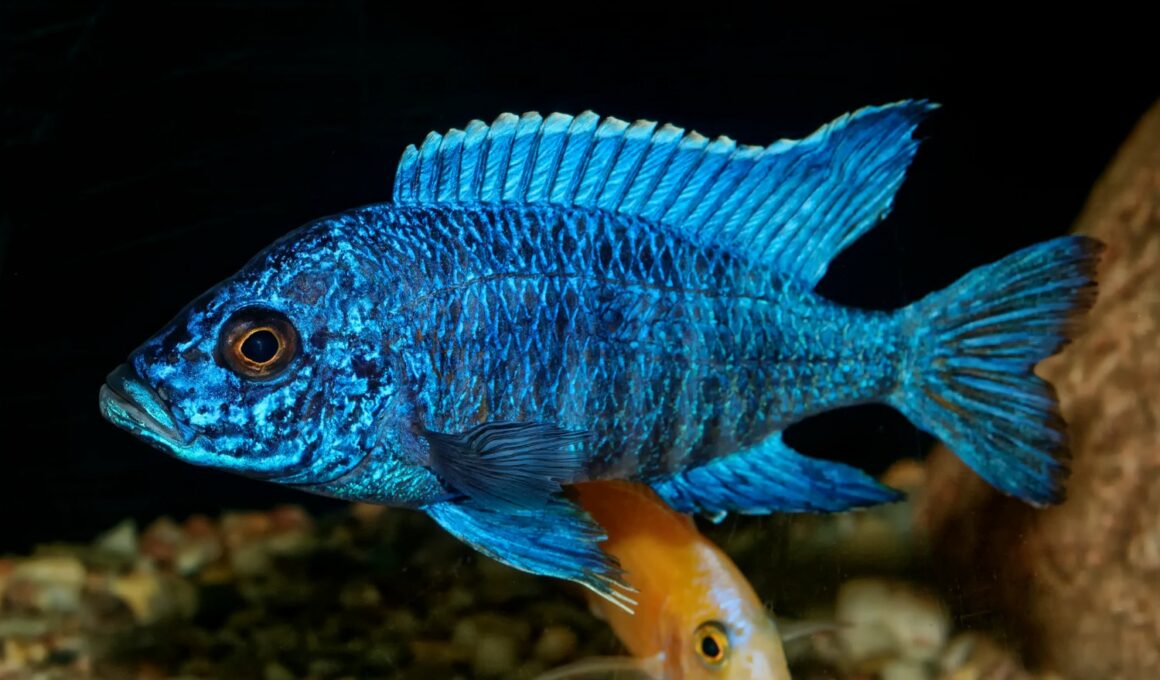In this article Show
As someone who’s dedicated years to the art and science of fishkeeping, I’ve had my fair share of captivating and challenging experiences. African Cichlids, with their vibrant colors and diverse behaviors, are easily one of the most intriguing freshwater species to house.
But, like any unique fish, they come with their own set of needs – especially when it comes to choosing their roommates. Ensuring a harmonious tank environment is crucial, not just for the peace of your underwater community but for their overall well-being.
That’s why today, we’ll delve deep into the world of the best tank mates for African Cichlids. Whether you’re a novice aquarist curious about these mesmerizing creatures or a seasoned fish keeper looking to shake things up, this guide is tailored for you. So, let’s dive in!
Understanding African Cichlids
Navigating the world of African Cichlids can be a fascinating journey. With hundreds of species populating the African Great Lakes, these fish are a tapestry of colors, sizes, and behaviors.
Typical Behaviors and Characteristics
At the core, African Cichlids are known for their vivaciousness. Their active nature means you’ll frequently see them darting around, chasing tank mates, or simply playing in the water currents. This isn’t just a sign of good health but is deeply ingrained in their behavior.
One key thing to note about these fish is their territorial nature. Particularly during breeding times, cichlids can become extremely protective of their designated space. It’s not uncommon to witness little skirmishes as they establish dominance. This trait underscores the importance of ensuring ample hiding spots and spaces in your tank setup.
In terms of physical characteristics, their dazzling colors are, without doubt, their most distinguishing feature. From the radiant blues of the electric blue cichlid to the yellows of the sunshine peacock, their hues can rival any saltwater fish in sheer vibrancy.
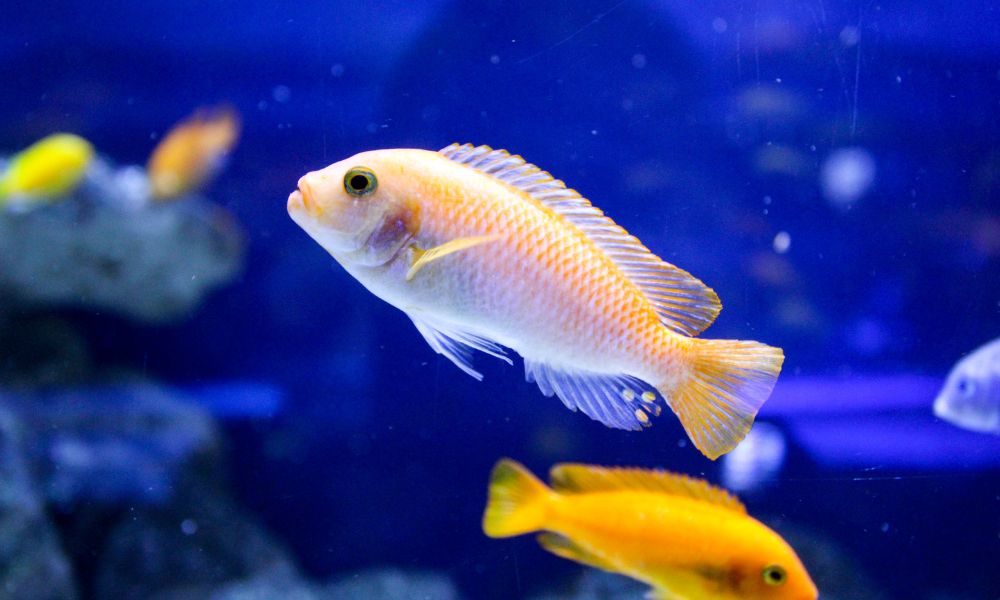
The Varying Types and Regions
The African continent boasts several expansive lakes, each hosting its unique cichlid population. Two of the most renowned are Lake Malawi and Lake Tanganyika.
Lake Malawi
Home to the majority of African Cichlid species, this lake offers an array of fish, with the most popular being the Mbuna (rock-dwellers), Peacocks, and Haps. Each comes with its own set of colors, temperaments, and care requirements.
Lake Tanganyika
This ancient lake, believed to be one of the oldest in the world, houses cichlid species that are a bit different in behavior and appearance than their Lake Malawi counterparts. Examples include the Frontosa, Shell-Dwellers, and Julidochromis.
Diversifying your tank with species from these lakes can create a delightful visual spectacle, but it’s paramount to understand their specific needs and compatibility. In subsequent sections, we’ll cover how to achieve just that.
Primary Concerns with African Cichlid Companionship
Choosing tank mates for African Cichlids isn’t as simple as pointing at a fish in a pet store and saying, “I’ll take that one.” There are significant concerns to bear in mind, given the unique temperament and needs of cichlids. Here, we delve into some of those primary concerns.
Aggression Levels and Territorial Behaviors
It’s no secret that African Cichlids are, by nature, quite feisty. Their vibrant colors and active swimming patterns might captivate you, but beneath that beauty lies a fish with a penchant for territory.
1. Same-species aggression
Often, you’ll notice that African Cichlids are more aggressive towards members of their own species. This is especially true for males who see each other as competitors, especially during mating seasons.
2. Territorial spots
A big part of their aggression stems from their territorial nature. They frequently establish “zones” in the tank, especially around breeding times. Any fish that ventures too close can become a target, be it a fellow cichlid or another species.
3. Establishing hierarchy
Like many social animals, African Cichlids tend to establish a pecking order. This means that a certain fish (usually the largest or most aggressive) will dominate, leading to power dynamics that might stress other fish.
Compatibility Based on Water Parameters, Diet, and Hiding Spots
African Cichlids hail from specific water conditions in the wild, and they bring these requirements with them into the home aquarium.
1. Water parameters
Native to the alkaline waters of the African Great Lakes, cichlids prefer a higher pH level, usually between 7.8 to 8.6. Introducing fish that thrive in significantly different water conditions might lead to health issues for either party.
2. Dietary needs
African Cichlids are mainly omnivores. While they’ll happily snack on a mix of plants and proteins, certain species lean more towards one diet type. Ensuring that their tank mates have similar dietary preferences will make feeding times smoother and prevent potential nutrient deficiencies.
3. Hiding spots are essential
Given their territorial nature, cichlids need plenty of hideouts. These provide them with a sense of security and reduce aggressive confrontations. Therefore, when adding tank mates, ensure there’s enough space and hiding spots to accommodate everyone.
Best Tank Mates for African Cichlids
Pairing African Cichlids with suitable tank mates often involves turning to their own kind. Certain cichlid species tend to have compatible temperaments and similar environmental needs, making them ideal candidates. Let’s delve into some of these species:
Other Cichlids
1. Peacock Cichlids
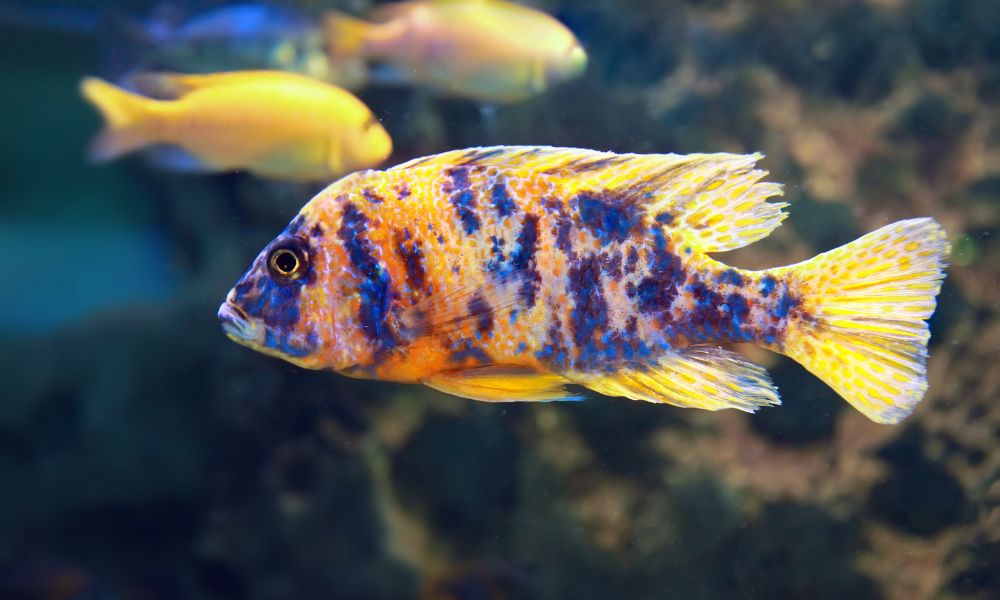
| Size | 4-6 Inches |
| Diet | Omnivore |
| Temperament | Semi-Aggressive |
| Care Level | Intermediate |
| Minimum Tank Size | 55 gallons |
Native to Lake Malawi, Peacock Cichlids are one of the most colorful cichlid variants. They tend to be less aggressive than most Mbuna species, particularly when given ample space. Their diet consists of a mix of protein and plant matter. While they are relatively hardy, they do appreciate a well-maintained tank with stable water parameters.
2. Yellow Labs
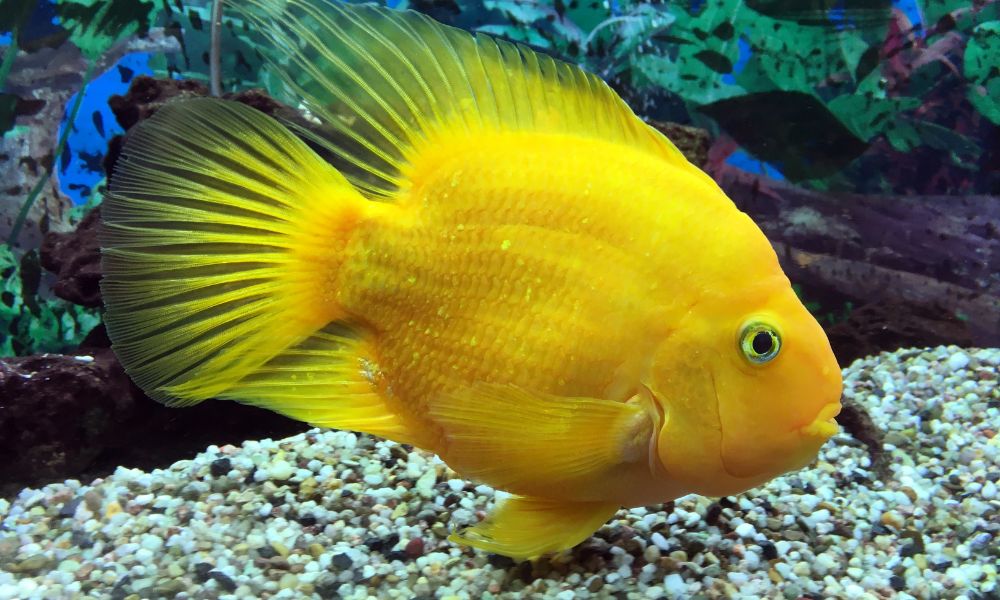
| Size | 3’6 Inches |
| Diet | Omnivore |
| Temperament | Peaceful to Semi-Aggressive |
| Care Level | Intermediate |
| Minimum Tank Size | 30 gallons |
Hailing from Lake Malawi, Yellow Labs is a splash of bright lemon-yellow in the tank. They are among the more peaceful Mbuna cichlids, but like all cichlids, they can display territorial behaviors, especially during breeding. They thrive on a varied diet of both plant matter and protein sources.
3. Mbuna Species
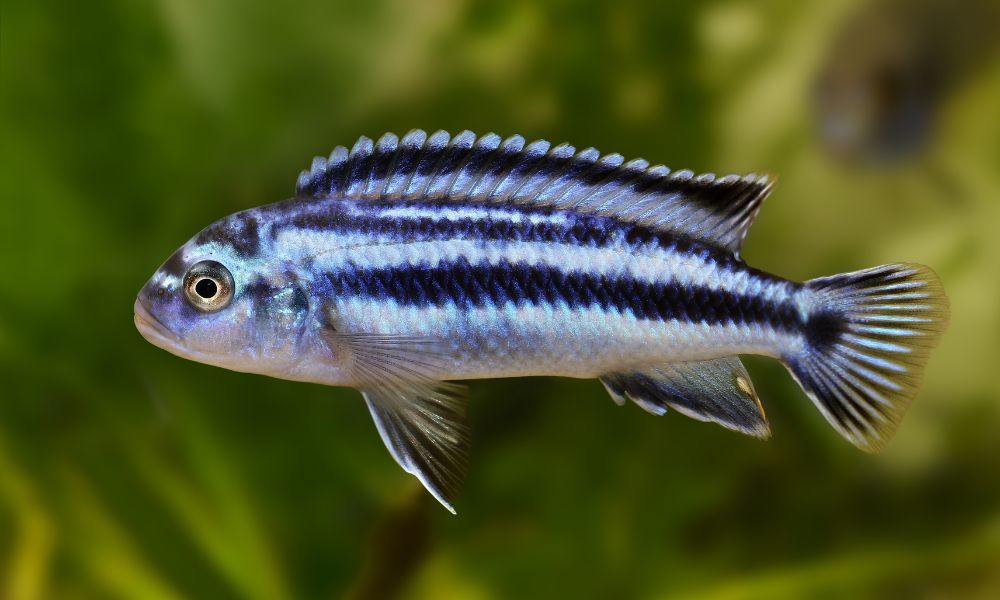
| Size | 3-5 Inches |
| Diet | Omnivore to Herbivore |
| Temperament | Typically Aggressive |
| Care Level | Intermediate |
| Minimum Tank Size | 50 gallons |
The term ‘Mbuna’ translates to ‘rockfish’, referencing their preferred rocky environments in Lake Malawi. They’re colorful, and active, and tend to establish territories within the tank. Diet varies with species but often leans towards plant matter.
4. Aulonocara Jacobfreibergi
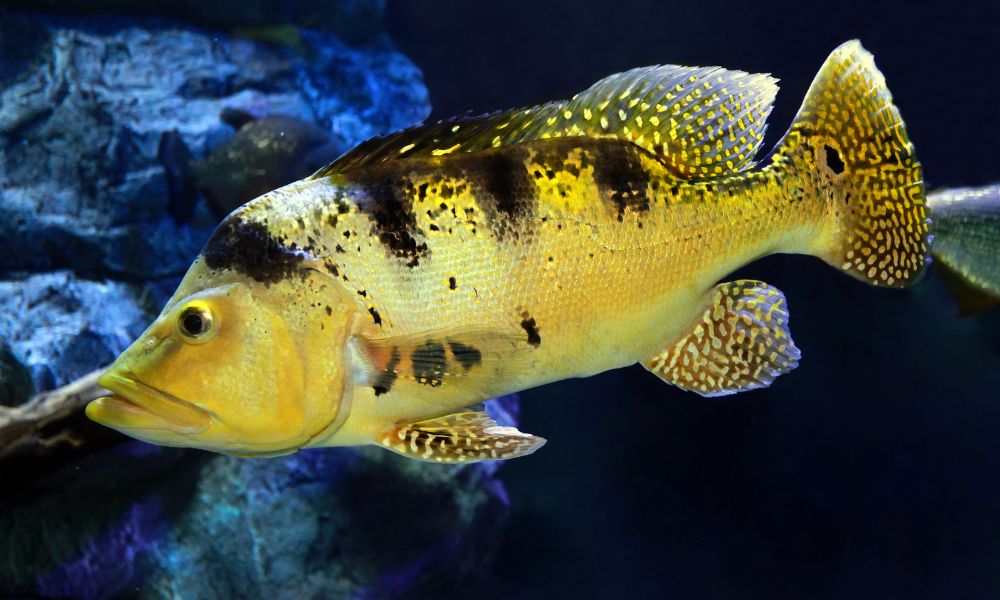
| Size | 4-8 inches |
| Diet | Carnivore |
| Temperament | Semi-Aggressive |
| Care Level | Intermediate |
| Minimum Tank Size | 55 gallons |
A popular variant of the Peacock Cichlids, these fish flaunt a combination of blues, yellows, and reds. Native to Lake Malawi, they are carnivorous, preferring a diet of small invertebrates. Their temperament is relatively peaceful for cichlids, but males can become territorial, especially during spawning.
5. Tropheus Species
| Size | 4-5 Inches |
| Diet | Herbivore |
| Temperament | Aggressive |
| Care Level | Advanced |
| Minimum Tank Size | 50 gallons |
Tropheus cichlids are unique and demand a bit more from their keepers. They hail from Lake Tanganyika and have a strictly herbivorous diet. Their aggressive nature can sometimes make them a challenge in a community tank, but with the right setup and tank mates, they can be a rewarding species to keep.
Catfish Varieties
Diversifying your African Cichlid tank with catfish can be a great idea. Not only do they offer a different aesthetic, but they often occupy the bottom levels of the tank, making them less likely to interfere with the cichlids’ territories. Here are some of the top contenders:
6. Synodontis Catfish
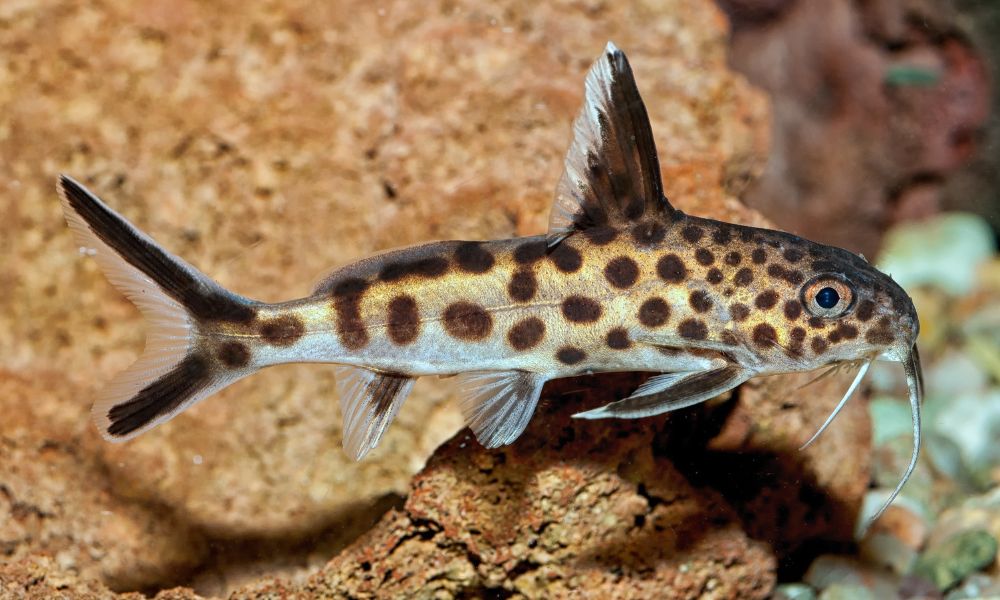
| Size | 6-8 inches |
| Diet | Omnivore |
| Temperament | Peaceful |
| Care Level | Intermediate |
| Minimum Tank Size | 55 gallons |
Originating from the same African lakes as many cichlids, Synodontis Catfish naturally coexist with them in the wild. They’re peaceful bottom dwellers with intriguing patterns and offer a nice contrast to the vibrancy of the cichlids. Their diet is varied, consisting of both plant matter and protein-rich foods.
7. Plecos
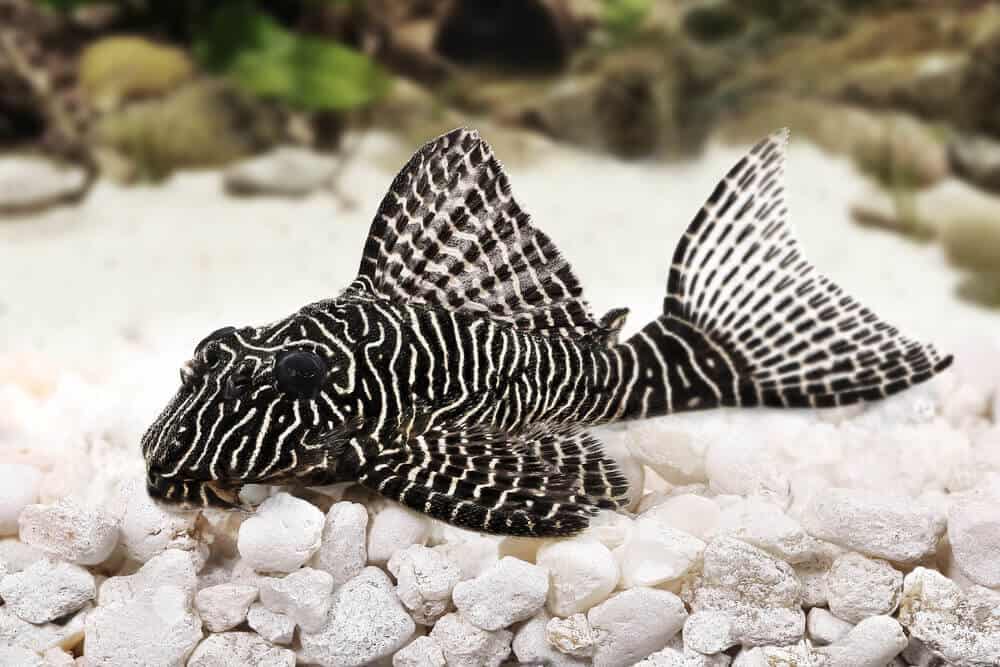
| Size | 4-24 inches (depending on species) |
| Diet | Herbivore/Omnivore |
| Temperament | Peaceful to Semi-Aggressive |
| Care Level | Intermediate to Advanced |
| Minimum Tank Size | 30-150 gallons (depending on species) |
Plecos are a broad category with many species, and while some can cohabitate with African Cichlids, it’s essential to choose the right type and size. Some Plecos can grow quite large and may require a larger tank. They primarily feed on algae, but many will also eat other foodstuffs, making them a good choice for tank cleaning.
8 African Featherfin Catfish
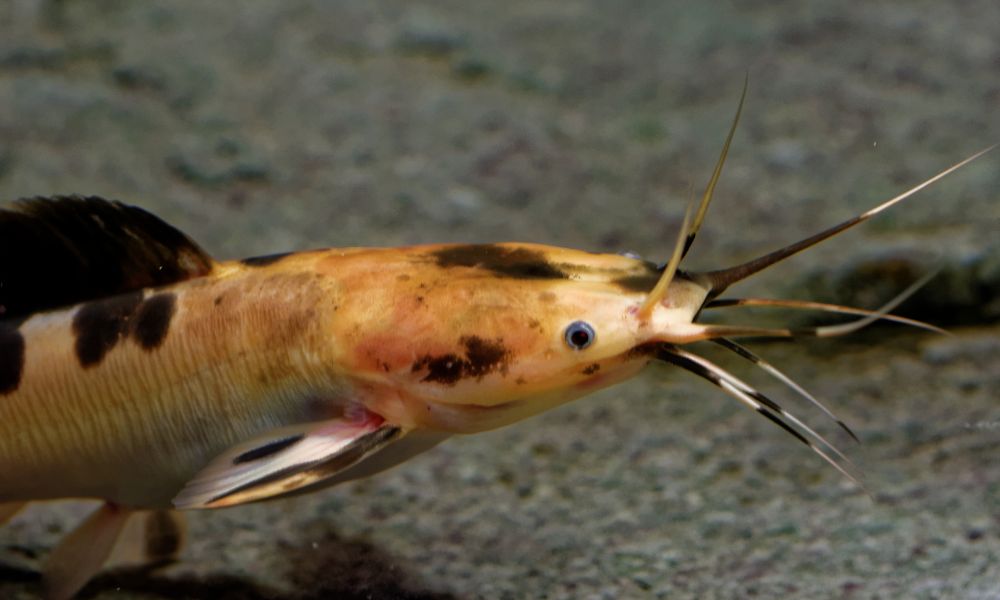
| Size | 6-8 inches |
| Diet | Omnivore |
| Temperament | Peaceful |
| Care Level | Intermediate |
| Minimum Tank Size | 55 gallon |
The Featherfin catfish is another Synodontis variant recognized for its striking finnage. Native to the Nile and Niger river basins, they are used to coexisting with cichlids and are non-aggressive. Their diet includes algae, wafers, and occasional protein sources like bloodworms.
9. Upside-Down Catfish
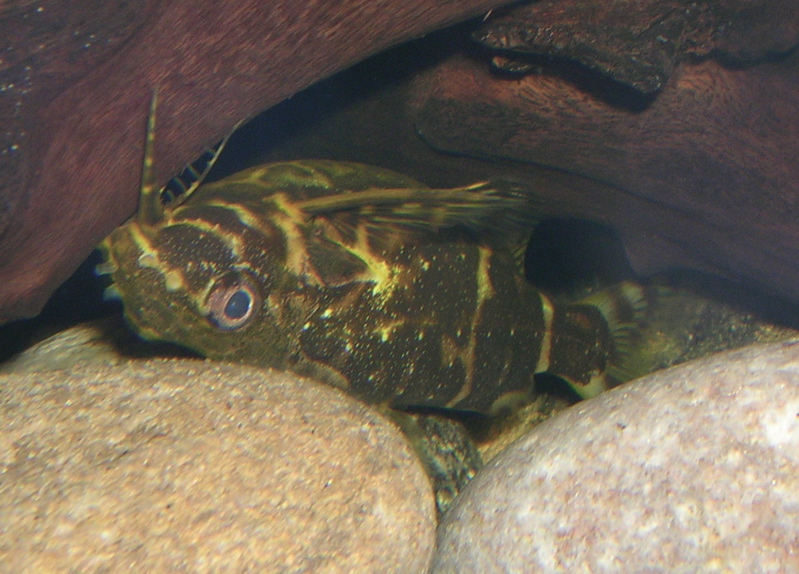
| Size | 3-4inches |
| Diet | Omnivore |
| Temperament | Peaceful |
| Care Level | Beginner to Intermediate |
| Minimum Tank Size | 30 gallons |
As the name suggests, this quirky catfish often swims upside down, especially when feeding. Native to the Congo River Basin, they’re smaller than many Synodontis species and can be an excellent fit for cichlid tanks. They’re peaceful and enjoy a varied diet, including flake food, pellets, and live food.
Other Compatible Fishes
While cichlids and catfish often take the spotlight in African-themed tanks, there are other fish species that can also coexist harmoniously with African Cichlids. They can add variety in behavior, appearance, and swimming levels. Here are some excellent choices:
10. Larger Tetras
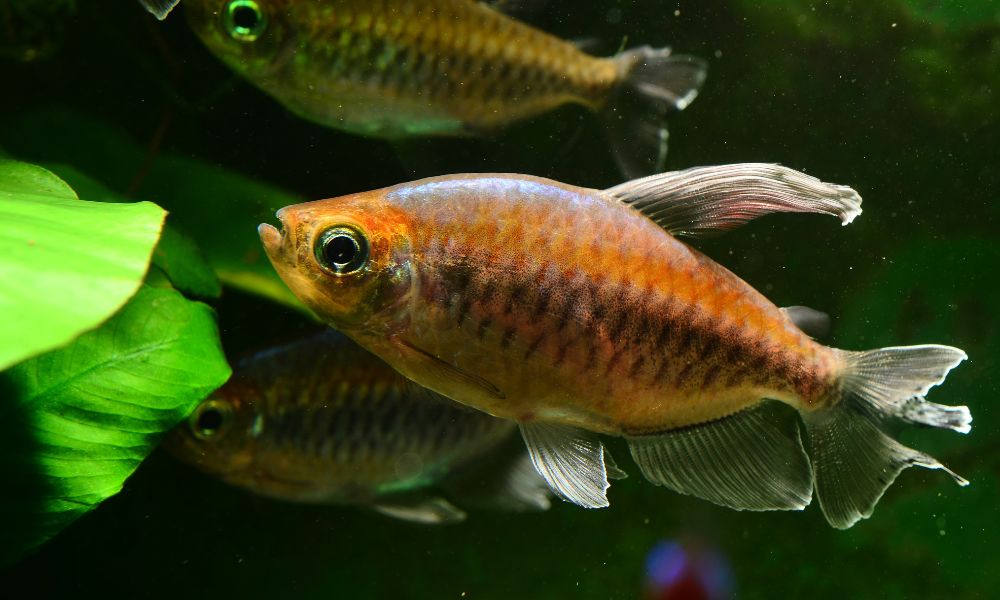
| Size | 2-3 inches |
| Diet | Omnivore |
| Temperament | Peaceful |
| Care Level | Beginner |
| Minimum Tank Size | 20 gallons |
While many tetras are too small and delicate for an African Cichlid tank, larger species like the Congo Tetra can thrive. Originating from Central Africa, they are used to similar water parameters and can dodge the occasional cichlid chase with their swift movements.
11. Clown Loaches
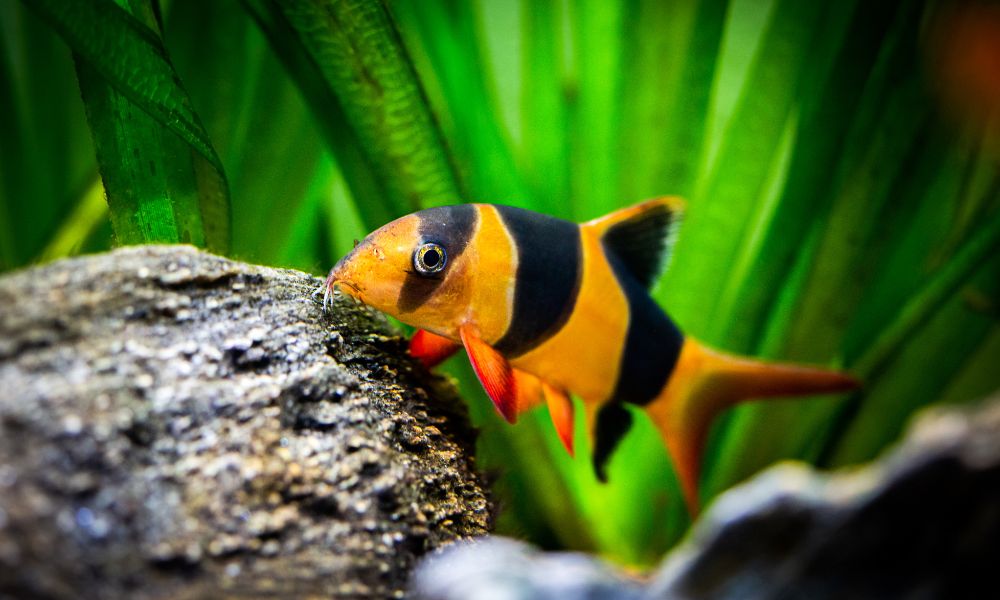
| Size | 10-12 inches |
| Diet | Omnivore |
| Temperament | Peaceful |
| Care Level | Intermediate |
| Minimum Tank Size | 75 gallons |
Clown Loaches, with their striking patterns and playful behavior, are a popular choice. They enjoy being in groups and often retreat to hiding places, making them less prone to cichlid aggression. However, they can grow relatively large and require a spacious tank.
12. Rainbowfish
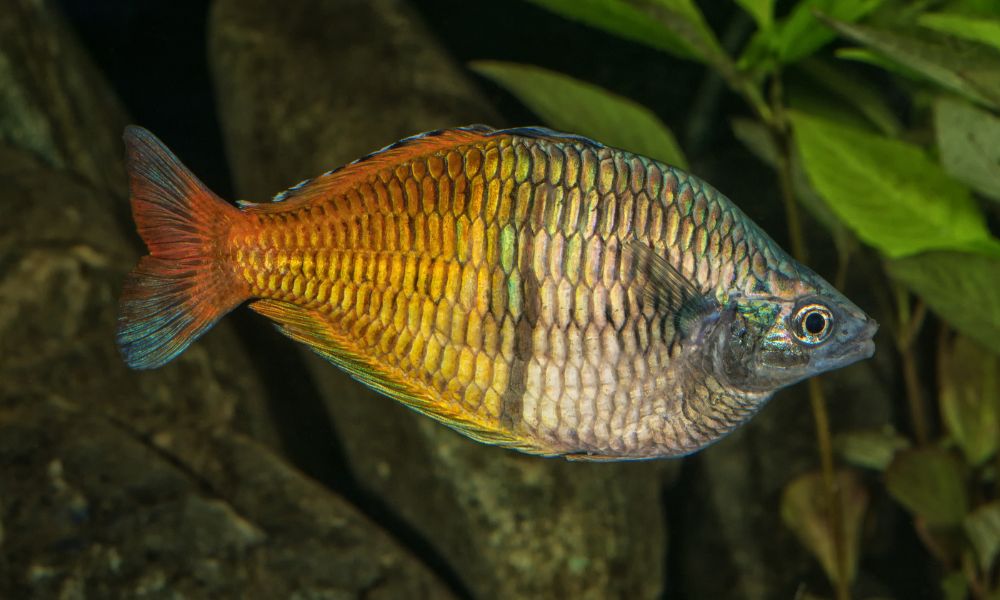
| Size | 2-4 inches |
| Diet | Omnivore |
| Temperament | Peaceful |
| Care Level | Intermediate |
| Minimum Tank Size | 30 gallons |
Rainbowfish, with their shimmering scales, can add a splash of color and activity to the upper levels of the tank. They’re fast swimmers and can coexist with African Cichlids, especially in larger setups where territories are well-established.
13. Silver Dollars
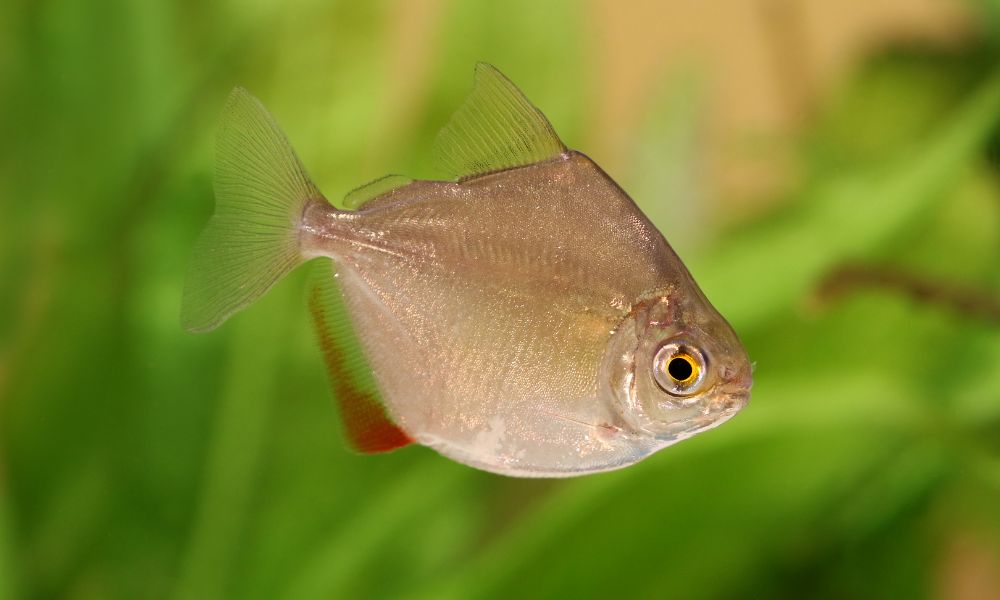
| Size | 5-6 inches |
| Diet | Herbivore |
| Temperament | Peaceful |
| Care Level | Beginner |
| Minimum Tank Size | 55 gallons |
Silver Dollars are disc-shaped fish known for their peaceful nature. They’re herbivores, primarily feeding on plant matter. Their size and temperament make them relatively safe from cichlid aggression.
14. Bala Sharks
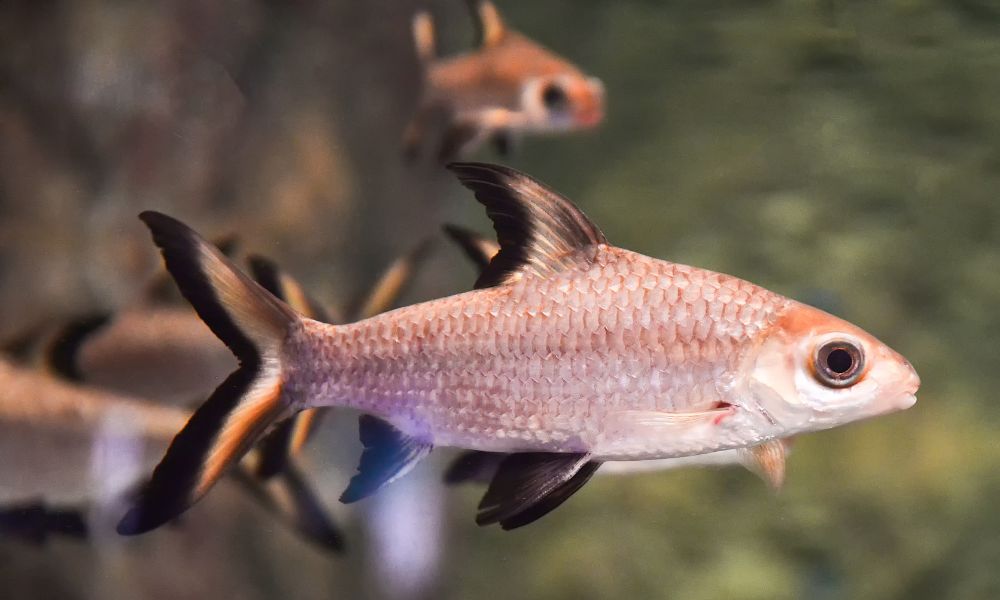
| Size | 10-12 inches |
| Diet | Omnivore |
| Temperament | Peaceful |
| Care Level | Intermediate |
| Minimum Tank Size | 150 gallons |
Despite the name, Bala Sharks are not true sharks. They’re peaceful schooling fish with a streamlined body, known for their swift movements. They can grow quite large and prefer being in groups, so a spacious tank is essential.
15. Rosy Barbs
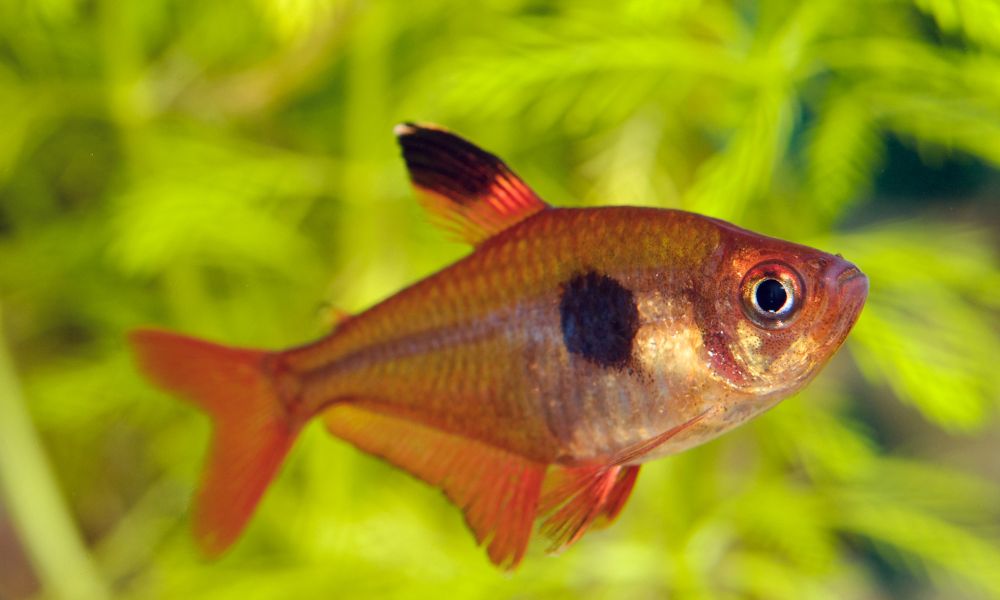
| Size | 4-6 inches |
| Diet | Omnivore |
| Temperament | Semi-Aggressive |
| Care Level | Beginner |
| Minimum Tank Size | 30 gallons |
Rosy Barbs are hardy fish that can adapt to various water conditions. They’re active swimmers and can hold their own in a tank with African Cichlids. Their attractive reddish-pink hue adds a different color palette to the tank.
Factors To Consider For Tank Cohabitation
Creating a harmonious aquatic environment requires more than just selecting compatible fish species; it necessitates a holistic approach to the entire tank environment.
To ensure that your African Cichlids and their tank mates thrive, let’s delve into some of the primary factors for successful cohabitation:
Tank Size and Setup
1. Volume
Ensure the tank provides adequate space for all inhabitants. A cramped tank can heighten stress and aggression. As a general rule of thumb, larger tanks tend to be more forgiving when it comes to territorial disputes.
2. Dimensions
Length and width are often more critical than height for many species, as they provide more swimming and territorial space.
3. Water Parameters
Maintain water conditions optimal for all species. This includes pH, temperature, and hardness. Regular water testing is crucial.
4. Filtration
A robust filtration system ensures a clean environment and reduces harmful elements like ammonia and nitrites.
Number of Hiding Places, Rocks, and Caves
1. Hiding Spots
Providing ample hiding spots can significantly reduce stress and territorial disputes. It allows fish to establish their own “zones” and retreat if they feel threatened.
2. Natural Barriers
Rocks and driftwood can serve as natural dividers, allowing you to create distinct territories within the tank.
3. Cave Systems
Caves are particularly beloved by African Cichlids, especially during breeding seasons. They offer a secure location for laying eggs and shielding fry.
4. Plant Coverage
While some African Cichlids may nibble on plants, certain hardy species can offer additional hiding spots and break lines of sight, further reducing aggression.
Monitoring Dietary Needs
1. Species-specific Diet
While many tank inhabitants might be omnivores, their specific nutritional needs can vary. It’s essential to provide a varied diet catering to all inhabitants.
2. Feeding Zones
To ensure every fish gets its fair share of food, consider having distinct feeding zones. For instance, sinking pellets for bottom dwellers and floating flakes for top and mid-level swimmers.
3. Overfeeding
Overfeeding can lead to multiple issues, from water pollution to health problems in fish. Feed in small amounts and ensure all food gets consumed.
4. Dietary Supplements
For certain species, supplements like vitamins or specific minerals might be necessary. Research each species’ needs thoroughly.
Tips For Introducing New Tank Mates
Introducing new fish into an established aquarium can be a delicate process. Whether you’re bringing in a new cichlid or a different species altogether, ensuring a smooth transition is critical for the health and well-being of all your aquatic pets.
Here’s a comprehensive guide to help you seamlessly introduce new tank mates:
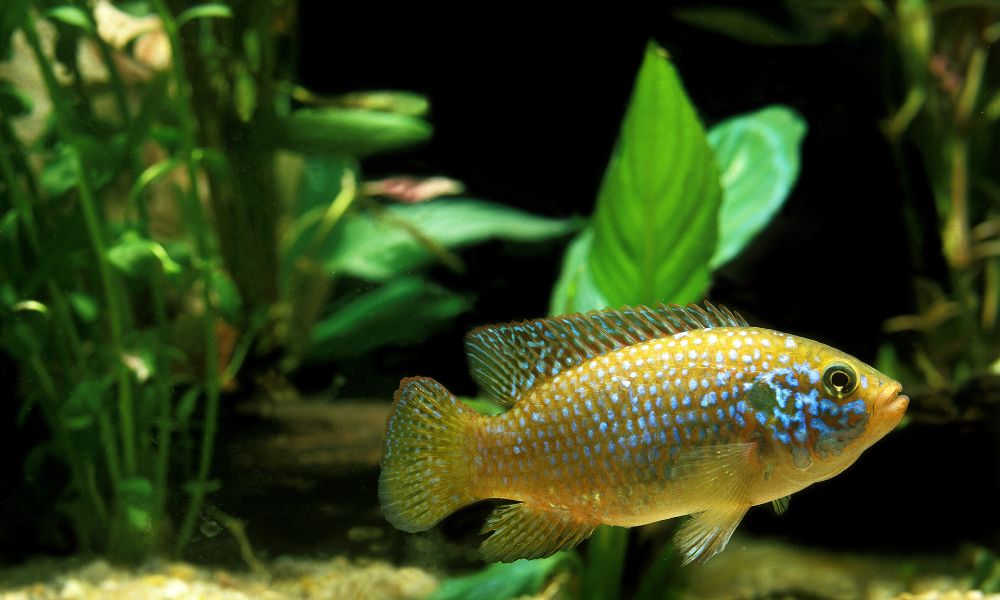
Quarantining New Fish
1. Purpose
Quarantining provides a separate environment for new fish before they join the main tank. This helps in monitoring them for illnesses and prevents potential spread to established fish.
2. Duration
Typically, a quarantine period of 2-4 weeks is recommended. This allows ample time to observe any latent illnesses or parasites.
3. Tank Setup
The quarantine tank doesn’t need to be elaborate. A simple setup with a filter, heater, and some hiding spots will suffice. Ensure water parameters match the main tank.
4. Medication
It’s wise to have a general anti-parasitic and antibacterial treatment on hand. Use only if you observe symptoms of illness.
Gradual Introduction and Observation
1. Acclimatization
Slowly acclimatize new fish to the water conditions of the main tank. This can be done by floating the bag they came in and gradually mixing tank water into the bag over an hour.
2. Observation
Once released, keep a close eye on the interactions between the new arrivals and existing residents. Look for signs of aggression or bullying.
3. Nighttime Introduction
Some aquarists introduce new fish during the evening or with the lights dimmed. This can reduce immediate aggression, allowing the new fish to find hiding spots in relative peace.
The Use of Tank Dividers if Necessary
1. Purpose
Dividers physically separate sections of the tank, allowing fish to get used to each other’s presence without direct contact.
2. Material
Commercial tank dividers are available, or DIY versions can be made using mesh or perforated plastic. Ensure water can flow through for consistent filtration and temperature.
3. Duration
Depending on the aggression levels, dividers can be kept for a few days to a couple of weeks. The goal is to have both old and new fish adjust to each other’s presence.
4. Benefits
Beyond initial introductions, dividers can also be handy during breeding periods or if specific fish need a temporary timeout due to excessive aggression.
What to Avoid in African Cichlid Tanks
While African Cichlids bring color and life to an aquarium, they also come with specific requirements and behaviors that aquarists need to be aware of. To ensure the well-being of both cichlids and any potential tank mates, here are some pitfalls you should steer clear of:
Incompatible Fish Species
1. Predatory or Aggressive
Fish Introducing species known for their aggressive behavior can escalate tensions in the tank, leading to constant skirmishes or worse.
2. Small or Delicate Fish
Smaller fish like guppies or smaller tetras can easily become targets for cichlids, either as perceived threats or as potential meals.
3. Different Water Requirements
Fish like goldfish prefer cooler water and different pH levels, making them unsuitable tank mates for African Cichlids, who thrive in warmer, more alkaline waters.
4. Bottom Dwellers
While some bottom dwellers can coexist with cichlids, those that are slow, have long fins, or are not accustomed to the cichlid’s temperament can face challenges.
Overcrowding
1. Stress Levels
Overcrowding can increase stress among fish, leading to health issues and heightened aggression.
2. Water Quality
An overstocked tank can lead to rapid water degradation, demanding more frequent maintenance and increasing the risk of diseases.
3. Limited Resources
Too many fish can lead to competition for food, hiding spots, and territory, which can further escalate tensions in the tank.
Misjudging the Adult Size of the Fish
1. Growth
Many fish, when purchased, are juveniles and can grow significantly. It’s essential to plan for their adult size to ensure ample space in the future.
2. Tank Requirements
A fish that’s comfortable in a 30-gallon tank as a juvenile might require a 70-gallon or larger setup as an adult.
3. Behavioral Changes
As fish mature, their behavior can change, especially concerning territoriality and aggression. It’s crucial to monitor and adjust as needed.
Conclusion
Successfully maintaining an African Cichlid tank means paying attention to the species you introduce, ensuring you don’t overcrowd the space, and always planning for the full growth potential of every fish. With lots of observation, you can create a harmonious environment for your aquatic community.






